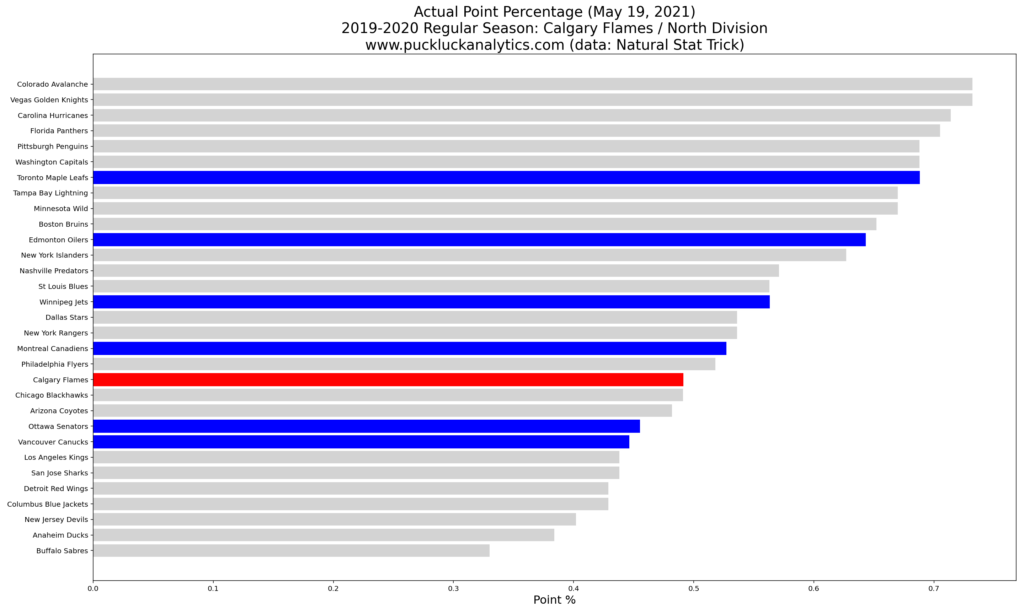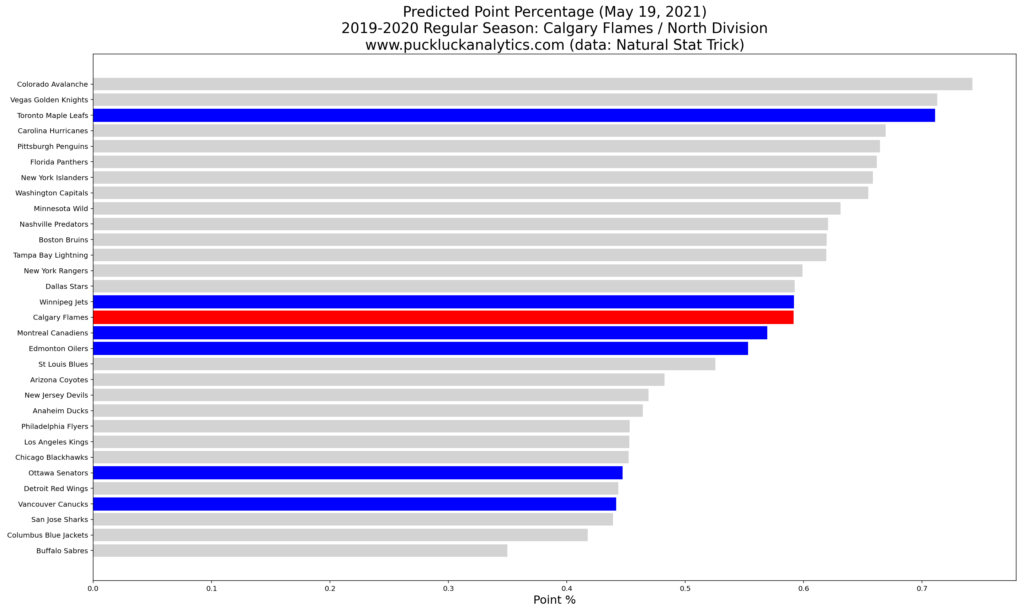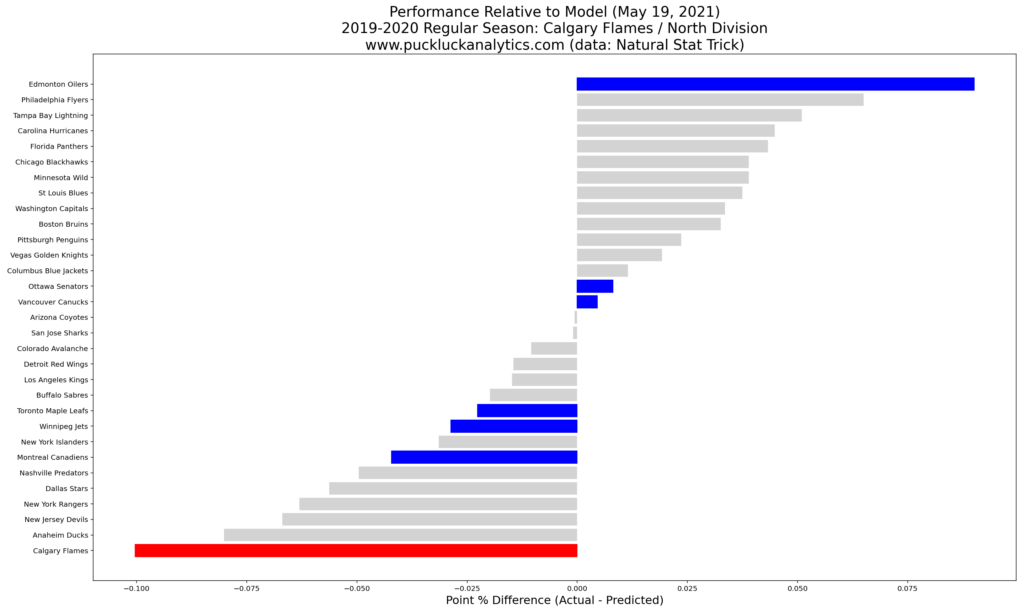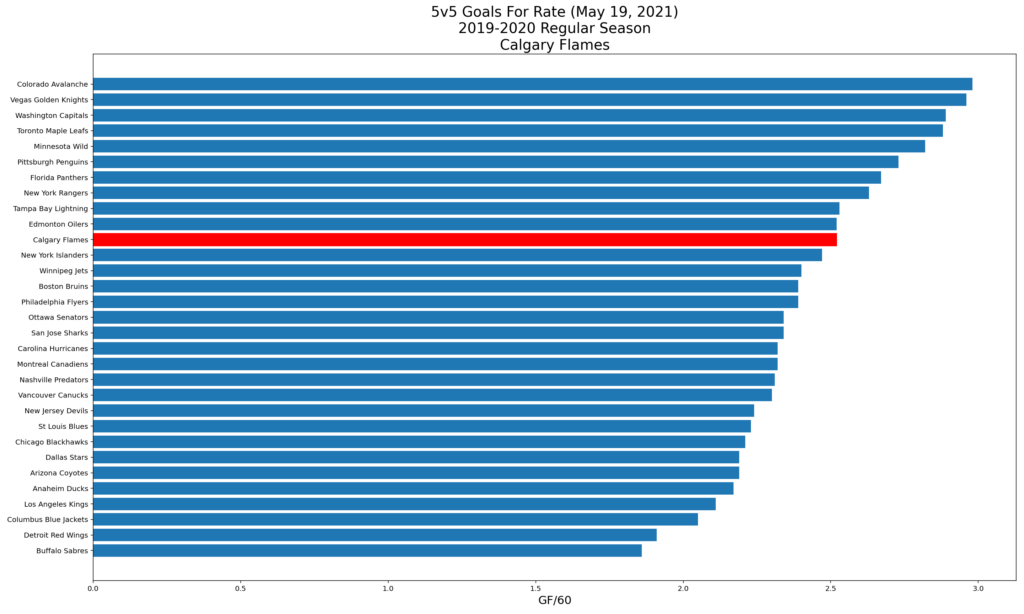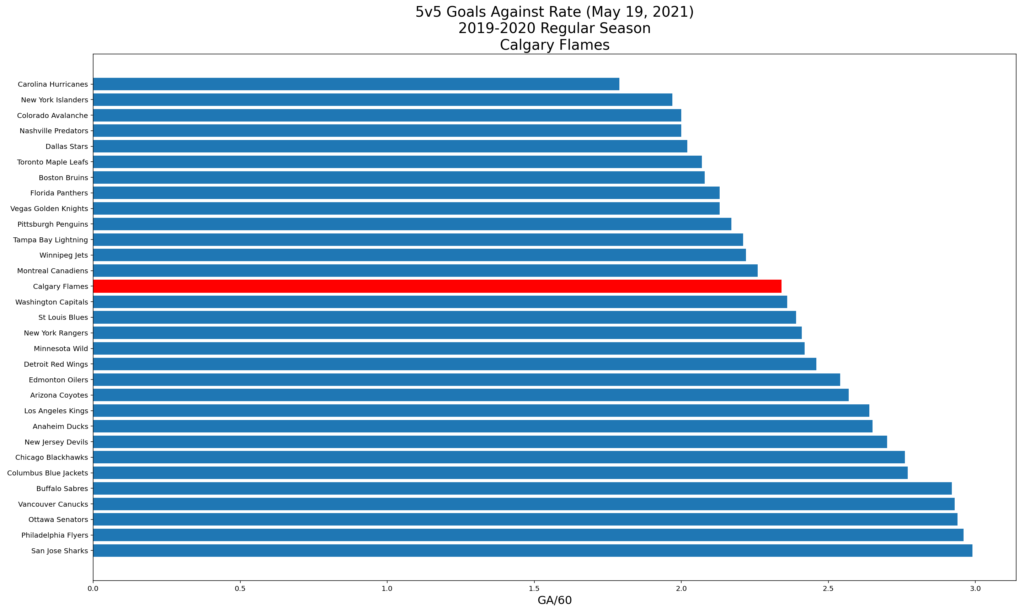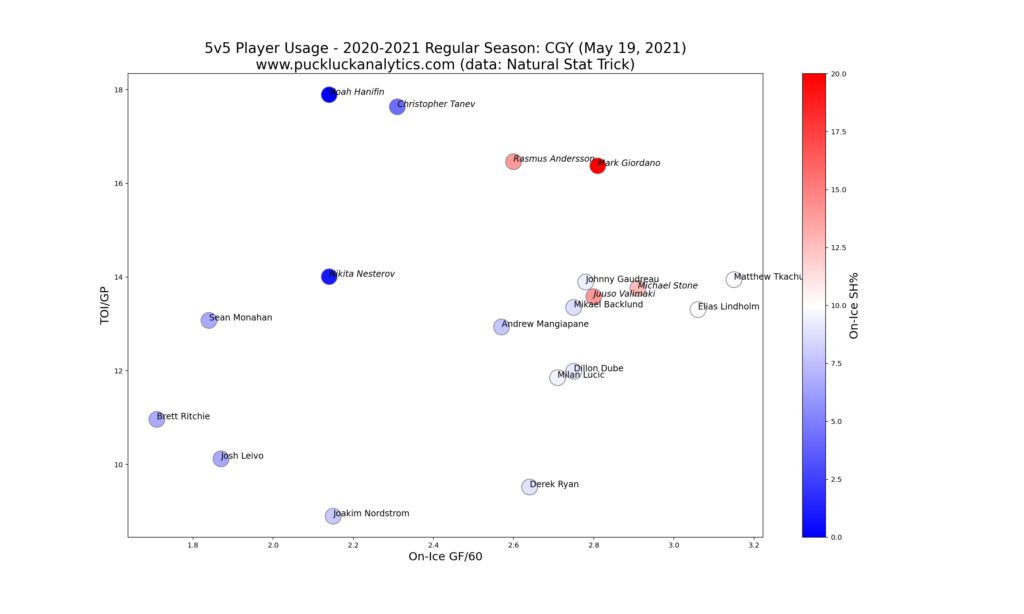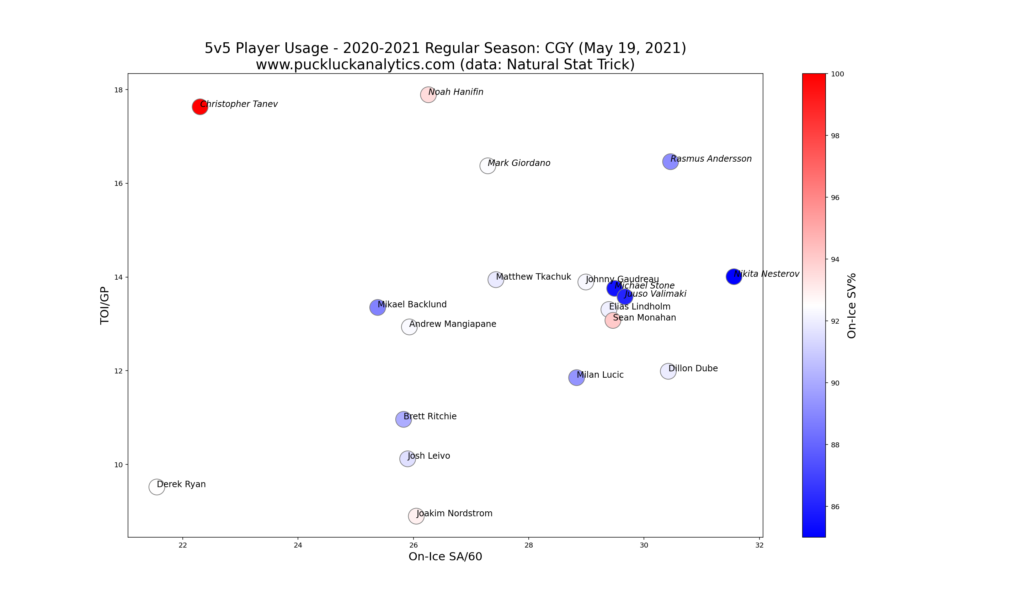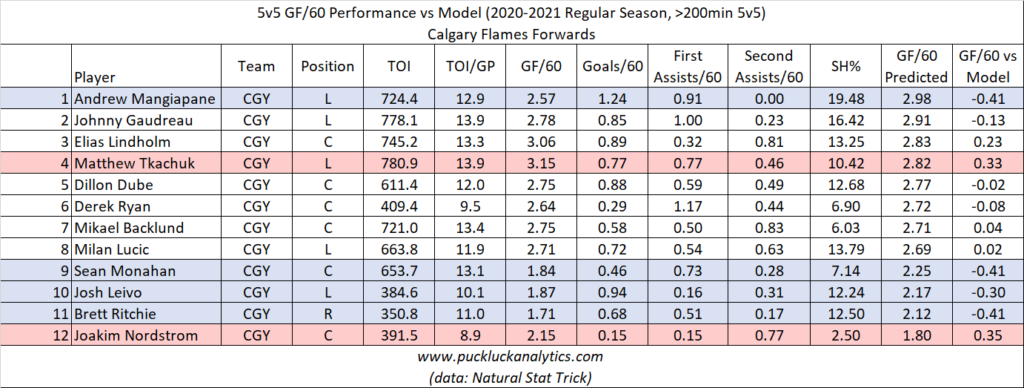It was a tumultuous season in Calgary. With expectations high entering the season, the Flames faltered early in the season, prompting a mid-season coaching change to bring Darryl Sutter back behind the bench. The Flames seemed to turn a corner late in the year under the new bench boss and they may have fought their way back into the playoff picture with more runway but they came up short in the 56 game season. Do the Flames have the pieces to become a contender with their current core? If you haven’t already, I encourage you to check out this post which provides more detail on the plots we’ll use in this season review.
Overall Performance
The Flames suffered from inconsistency this season, particularly early in the year. Let’s take a look at their actual results compared to our points predictor model which uses only 5v5 data to see how their underlying even strength game stacks up.
The Flames had the worst performance in the league relative to our model, which suggests that their 5v5 play was much stronger than their actual results indicate. Based on 5v5 play only, the model puts the Flames in a 4-way dog fight for playoff spots 2-4 in the North Division. This suggests the Flames have a better foundation to build on than the final standings indicate.
Let’s look at the 5v5 goal rates that feed the points predictor model.
The Flames 5v5 goal rates fell in the top half of the league both offensively and defensively but they weren’t elite in either category either. Putting the two together left them in the middle of the pack for GF%. With neither offense or defense standing out as a more problematic area, the Flames need to look for balanced improvement on both sides of the puck.
Player Performance
We’ll start looking at individual player performance using a player usage chart. Defensemen’s stats have been factored for comparison with forwards in this first chart. The result gives us a visual depth chart on the diagonal with the best players at the top right.
We see Johnny Gaudreau and Matthew Tkachuk at the top corner of the chart, as expected. Andrew Mangiapane also stands out as a top player after another strong season. There are a few players significantly off the diagonal line we expected, suggesting that the Flames players were not all utilized optimally. Above the line, we see Chris Tanev, Noah Hanafin and Sean Monahan who may have been over-utilized. In Tanev’s case, we can see his on-ice SA/60 was very low, so he was likely utilized more heavily for his defense. Hanafin may fit a similar explanation, as he was paired with Tanev for much of the season. On the other side of the chart, we see Jusso Valimaki and Derek Ryan appear to have been under-utilized. We’ll keep an eye on these players as we continue our review.
Plotting on-ice GF/60 vs TOI/GP gives us a visual for the relative offensive impacts of each player. Players further up and right on the chart contributed more to the team GF/60.
Tkachuk and Elias Lindholm stand out on this chart as the most impactful forwards offensively. Gaudreau is not far away and his impact may have been affected by playing with Monahan through much of the season. It is painfully obvious how poor Monahan’s season was offensively as we see him at the far left. While his shooting percentage improved in the second half, Monahan had a very poor shooting percentage in the first half of the season which undoubtedly affected Gaudreau’s assist totals.
We see defensemen Michael Stone and Jusso Valimaki sitting quite far right on the plot, showing they had good offensive impacts. We suspected Valimaki was under-utilized in the first usage chart and this gives us further reason to suspect it.
Let’s look at relative defensive impacts using a similar plot for SA/60 vs TOI/GP. This time, players further left and down had bettter impacts on team GA/60.
We see the strong defensive impacts from Tanev and Ryan on this plot. While Tanev looked over-utilized in the first chart, this plot helps explain the value he provided outside of point production. Ryan, on the other hand, already looked under-utilized and we now see that this defensive impact was strong. This gives us further reason to suspect he should have a larger role to optimize his impact.
With the league average for players with over 200 minutes played at 5v5 being 30 SA/60, the Flames look like they are in a good place defensively overall. There are only three players above the league average, and only by a small amount.
Let’s move on to our on-ice GF/60 models. Using these models, we get a sense for which players carried their line mates offensively by looking at the variance between the model prediction and the actual on-ice GF/60. While we need to keep an eye out for shooting percentage effects on the model, generally players with negative variances carried their line mates and variances greater than about 0.3 are noteworthy.
Starting with forwards, there is a lot to digest. First, we see the strong play of Mangiapane at the top of the chart. However, before we jump to the conclusion that he is the new face of the Flames offense, we need to look at his shooting percentage. We see his shooting percentage was through the roof this season which is inflating the model output. While we can expect another good season from him next year, the model prediction is likely on the high side. The other players we see with significant negative variances are near the bottom of the chart. For Josh Leivo and Brett Ritchie, we see shooting percentages on the high side as well and we should excercise caution before expecting them to perform in larger roles. Monahan also has a variance that suggests he carried line mates offensively, despite a poor offensive year by his standards. More important than the variance, we see him sit 9th among Flames forwards in predicted on-ice GF/60 which simply isn’t enough out of a top 6 forward.
Looking at noteworthy positive variances, Matthew Tkachuk jumps out. This is interesting in that it suggests that his offensive impact was buoyed by his line mates. Used more on the top line this year than in recent seasons, it may be that he is a better fit as a second line winger to provide optimal impact.
Moving on to the defense corps, there are no Flames defensemen who seem to have carried the offense when on the ice. Generally, it appears that the forwards drove the offense.
Earlier, we saw Jusso Valimaki and Michael Stone stand our as possibly under-utilized based on their offensive impact. However, we see a reason for that here. Both players have large variances from the model suggesting they were carried by others offensively. Mark Giordano is also noteworthy here. While he was still a valuable contributor this season with the highest predicted on-ice GF/60 on the team, he is 37 and the negative variance may be an indicator that his offensive impact is on the decline.
The Flames brought in Jacob Markstrom to be their number one goalie last offseason. His numbers this year were average and, while a mid-season injury may have hurt his numbers somewhat, the Flames will be looking for an improvement from him next season. With the departure of David Rittich at the trade deadline, the Flames need to find a competent backup for next season. With improvement from Markstrom and the addition of a competent backup combined with the generally strong defensive play we saw earlier, the Flames could become an elite defensive team next season.
Looking Ahead
With just under $68M already committed to the 2021-2022 cap, the Flames will have to be prudent while looking to improve their roster this offseason.
Key RFAs:
Dillon Dube is the most notable forward that is an RFA this summer. While his offensive impact makes him a competent middle 6 forward, we saw that he was among the worst defensive impacts on the team.
On defense, Jusso Valimaki, Connor Mackey, and Oliver Kylington are all RFAs. Valimaki is the most intriguing of the three as we saw a mixed bag from him in our review. He showed some signs that he has potential to take on a larger role and other signs that suggest he isn’t ready yet.
Key UFAs:
Derek Ryan is headed for unrestricted free agency this offseason. As a player that looks like he was under-utilized in Calgary, there will certainly interest in his services around the league. The Flames have a number of other depth players headed for free agency which leaves them some roster positions to fill prior to puck drop next fall.
Key Players Under Contract:
Elias Lindholm was possibly the Flames most consistent forward this year. As one of the top players on the roster, his $4.85M cap hit provides excellent value. Likewise, Mangiapane continued to develop into a solid top 6 forward this season and he is under contract for another year at with a modest cap hit of $2.425M. On the back end, Noah Hanafin took a big step forward this season and the Flames will look for the 24 year old to take another step next season.
Tough Questions:
Is it time to blow up the core in Calgary? The Flames have failed to get passed the first round since 2015, including missing the playoffs 3 times. Heading into next season with largely the same roster looking for a different result seems foolhardy. Monahan looked like the obvious forward to move based on our review. With a hip injury likely affecting his impact this season, the risk of selling low on Monahan seems high if he is moved this offseason. We saw Tkachuk appeared to be carried offensively by his line mates in our review. There would certainly be interest around the league if he was made available so he may be option that could net a better return. The Flames will also have to decide whether to protect captain Giordano in the expansion draft over one of their young defensemen. With signs that his offensive impact is starting to wane, they may be best off to leave him unprotected.
Offseason Priority:
It seems unlikely that the Flames are ready to give up entirely on their current core. If the Flames get a bounce-back season from Markstrom, they have the makings of a strong defensive team and some added scoring could make them a dangerous team. There has been a gaping hole on the right side of the top six for the past few seasons and that hole needs to be filled with a high impact top 6 winger. The Boston Bruins may provide a good reference for an upgrade. With the addition of Taylor Hall at the trade deadline, the Bruins diversified their offense and became a much more dangerous team. Adding a high impact player by giving up some lower impact pieces, such as Dube or Valimaki, could be a game changer for the Flames.
Check out the other season reviews that are already up, such as the Vancouver Canucks and Ottawa Senators, and subscribe to catch the rest of my season reviews as they come out.
data: Natural Stat Trick
cap data: CapFriendly

